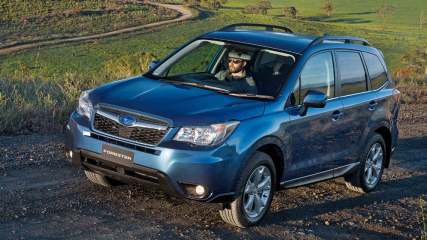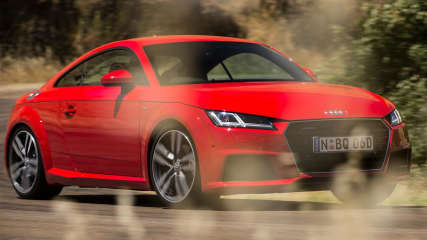Renault Clio Dynamique 2015 review
By Derek Ogden · 02 Apr 2015
Many car owners like nothing better than to stand out in a crowd and automobile makers are only too happy to lend a hand...at a price. The European brands are very accommodating and offer customers a major shopping list of options. Take Renault, for example.I recently was in possession of one of the French manufacturer's new Clios as a test car, which with add-ons was like no other vehicle I had come across.The Oyster Grey mid-spec Clio TCe120 Dynamique, a six-speed automatic comes onto the market at the manufacturer's recommended price of $23,790. However, with, I presume, the typical Renault buyer in mind, the car had been loaded up with special features.The car did look a treatFor example, the paint was metallic, costing an extra $550; there was red exterior trim for $250; matching red dashboard and seat covering, $500; 17-inch Diamond Red alloy wheels, $750; and R-Link multimedia, $990, making the price as tested $26,830, plus on-roads.I had to admit, the car did look a treat and I suspect the fan of exotic kit such as that from Renault would not blink at forking out the extra three grand-plus to get heads turning.As mentioned, the small hatchback was a Clio Dynamique, one of four models in the range, the others being Authentique, Expression and GT.Not only has Renault come up with a smooth, desirable design – inspired, it says by the DeZir concept car – a vehicle that symbolised love (how French) – the company offers the affordable personalisation program, mentioned above, that it claims is unprecedented in this section of the light car market.The new Clio has a coupe-like profile, made even more so by hidden rear door handlesAlso first seen on the DeZir is the way the large Renault logo sits prominently on a gloss black background on the front and is made more distinctive by the headlight units, which include chrome details and LED daytime running lights.Available only in five-door form, the new Clio has a coupe-like profile, made even more so by hidden rear door handles. A lower ride-height, which aids aerodynamics, plus pronounced shoulder lines, add to the visually distinctive appearance.The latest Clio introduces two new in-car entertainment platforms – Renault's Media Nav and R-Link, both using an 18cm touchscreen display and enabling satellite navigation, radio, Bluetooth connectivity for hands-free operation or music audio streaming, as well as USB and 3.5mm connectors.Ideal acoustics inside the car are topped off without high volume distortion (duff-duff devotees note) through the use of speakers in the front doors which feature Bass Reflex technology. We are assured this is a world first, in which an additional cone provides the equivalent volume and listening enjoyment of a 30-litre speaker.The new Renault Clio TCe 120 engine mated to a six-speed EDC (Efficient Dual Clutch) automatic gearbox is a four-cylinder 1.2-litre petrol unit.Direct fuel injection and turbocharging result in maximum power of 88kW at 4900 rpm and peak torque of 190Nm at 2000rpm. Official fuel consumption of 5.2L/100km on the combined cycle and carbon dioxide emissions of 120g/km are claimed.The new Clio is the first light segment car to employ active vents in front of the radiator helping to reduce fuel consumption by adjusting the flow of air through the radiator as a function of the engine's cooling needs. Under normal running conditions in fast-flowing traffic, closure of the vents permits fuel savings. The bad news is it's of the order of just 0.1L/100km at a 130 km/h - the motorway speed limit in most European countries.Weight saving includes a smaller fuel tank, reduced from 55 to 45 litres, which has no impact on fuel range, thanks to the economy gains.Passive safety is taken care of with a reinforced body structure, high-efficiency frontal airbags, lateral head and thorax airbags, a pressure sensor to detect impending impacts, seat belts with (front seat) pre-tensioners and load limiters, anti-whiplash head rests, a luggage partition and anti-submarining front and rear seats.Standard active safety systems include Electronic Stability Control, ABS anti-skid braking, Emergency Brake Assist and Hill Start Assist.From the start, the Dynamique was lethargic, in Eco mode even more so. However, like a late afternoon gin and tonic, a top-up of 98RON petrol was received with pleasure, and had Clio stepping out with renewed vigour.Fuel efficiency was on the money with a figure of 4.5L/100km recorded on a motorway run, 7-plus litres a regular recording in and around town.Let's talk about R-Link. Unique to this function is R-sound, in which the driver can alter the sound of the engine to imitate a range of present-day Renault vehicles and the supposed sound of a people mover of the future.It all sounds a tasty dish for the discerning buyerFor some reason a MotoGP bike makes up the list. With the best will in the world, even with the windows fully wound down, allowing the wind and noise in, it was hard to imagine what it was really like to live like Marc Márquez through Maggotts and Becketts at Silverstone.Gimmicks aside, R-Link also is connected to the car's own electronic systems giving access to an advanced eco-driving function (Driving eco2) which analyses the driver's behaviour and provides advice to help reduce fuel consumption.








.jpg)
.jpg)

.jpg)
.jpg)

.jpg)
.jpg)
.jpg)